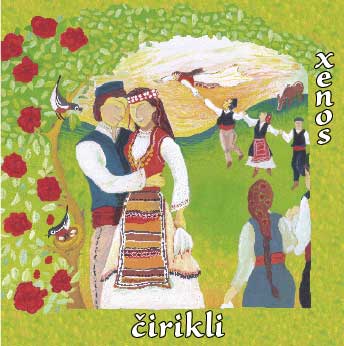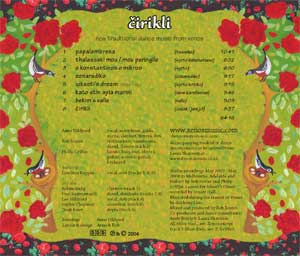
Čirikli - New Traditional Dance Music From Xenos
Čirikli is a banquet of beloved Balkan, Greek & Romani dance rhythms: syrto, valle, čoček, kalamatiano, tsamiko, zonaradiko, and karsilamas. The simplest, most widespread dances are also believed to be the most ancient, dating back centuries and possibly even millennia. Danced for weddings, panayiri, and all manner of celebrations, they are dances of affirmation and initiation, welcome and farewell. Xenos’ entrancing new versions of these traditional dances create a sense of timelessness and eternal renewal, in the ever-repeating rhythmic patterns which are our inheritance from the ancestors of the human family.
People once believed that magic lived in the instruments, and that dancing in circles could bless and protect the whole community. In our time, simply joining hands to dance together can be an act of faith, transcending differences and bridging ethnic divides. This is important work, when our world seems in danger of both losing cultural diversity and forgetting our common humanity. So come to the circle, feel the earth under your feet, and open your hearts and wings to kefi - the spirit of the dance!
Laura Shannon

click on the titles to play short 'real audio' samples.
1 papalambrena (tsamiko) 10:41 (track lengths on CD, samples are short)
2 thalassaki mou / mou paringile (syrto kalamatiano) 8:32
3 o konstantinos o mikros (syrto) 6:50
4 zonaradiko (zonaradiko) 9:17
5 iokasti’s dream (Ross Daly) (syrto kritiko) 9:15
6 kato stin ayia marini (slow karsilamas) 5:46
7 bekim’s valle (valle) 5:09
8 čirikli (čoček / jeni jol) 8:37
About the Dances
Papalambrena (tsamiko) The hypnotic slow-quick rhythm of the 3/4 metre tsamiko originated in northern Greece, and is now danced all over the country. A festival favourite in Findhorn, Glastonbury and Woodford, this haunting wedding song sympathetic to the mother of the bride was the original inspiration behind this CD. Picture yourself among hundreds of dancers, snaking and spiralling with friends and loved ones; the wedding celebration is joyful, but bittersweet, as the priest's wife grieves the loss of her favourite daughter.
Thalassaki Mou / Mou Paringile (syrto kalamatiano) Kalamatiano is a dynamic, earthy syrto in 7/8 metre, originally from the Greek mainland and now completely pan-Hellenic. In the Aegean, Thalassaki Mou is a favourite song for dancing kalamatiano, a lively syrto in 7/8 metre originally from the Greek mainland and now completely pan-Hellenic. Rob's plaintive tsambouna and Anne's impassioned singing evoke the island shepherds and the majestic solitude of their mountain homes.
O Konstantinos O Mikros (syrto) This song in honour of St Constantine comes from the Thracian firewalking ritual celebrated on May 21 in Ayia Eleni and other villages near the town of Serres in northern Greece. Clasping holy icons of Saints Constantine & Helena, the Anastenarides or Nestinari (‘they that sigh') dance in a trance state across burning coals. After the ritual, everyone joins in dancing a simple syrto around the fire. The villagers came as refugees from Bulgaria to Greece in the early 20th century; the firewalking dance ritual also survives in Bulgaria, and is believed to be a Christianised remnant of the ancient rites of Dionysus.
Zonaradiko (zonaradiko) The rapid 6/8 metre typical of Thrace invokes a sense of energy, expressed in the lead dancer's inspired improvisations yet contained by the earthy dance style. The pronounced zigzag pattern traced by the footsteps could illustrate lightning and fire, flowing water, the path of the serpent, or the waxing and waning cycle of life; all are equally appropriate to a dance from the homeland of Orpheus & Dionysus.
Iokasti's Dream (syrto kritiko) Philip took some of the more energetic sections of Ross Daly's epic tone-poem to create this dynamic arrangement. Accompanied by Tunji's sensitive deyra, Philip's mesmerising laouto becomes an exquisite channel for the complex traditional syrto from Crete. Combining complementary elements - slow/quick, right/left, open/closed, lift/step, structure/freedom - syrto kritiko allows us to balance the tension of these opposites within ourselves, and perhaps, by extension, in the larger world.
Kato stin Ayia Marini (karsilamas) The uneven 9/8 rhythm from Thrace effortlessly sustains the dance, whether it's a Pontian dipat, Macedonian tsourapia or a slow processional karsilamas down the village street to the wedding. Karsilamas means dancing ‘face to face', an important tradition of one-to-one improvisation which complements the circle dances. Agricultural peoples believed that dancing could bring fertile energy up from the underworld and into the circle, the crops and the community; St Marina, protector of crops, is still widely celebrated in rural areas and karsilamas is certainly danced on her feast day.
Bekim's Valle (valle) The valle of Albania and northern Epirus is a stately version of the three-measure pravo horo, the oldest and most common Balkan dance of all. Its six simple steps can be seen as an illustration of the Tree of Life, itself a symbol for the mother goddess originally worshiped throughout the same vast geographical area where the valle now thrives. We dance with the dignity and grace of the Tree itself, while Bekim's clarinet flows around our feet like life-giving water over our roots.
Čirikli (čoček / jeni jol) Finally, a much-requested extended version of the poignant Čirikli from the 2001 Xenos release, Tutti Frutti. New instrumental improvisations blend with the sisters' intense and intimate singing in an irresistible invitation to dance the čoček! Sublime Romani riffs and rhythms bring us home to our bodies and our souls, in an exultant affirmation of life which celebrates survival against all odds and despite all obstacles.
Laura Shannon